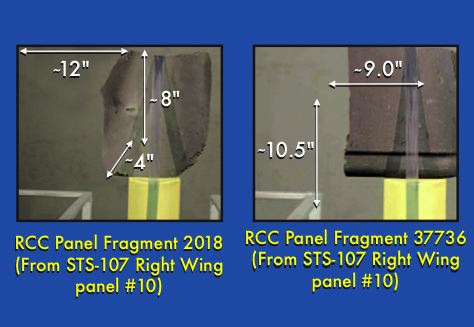3.5 On-Orbit Debris Separation - The "Flight Day 2" Object
3.5 On-Orbit Debris Separation - The "Flight Day 2" Object
− 軌道上での破片の脱落 - "Flight Day 2" Object −
− 軌道上での破片の脱落 - "Flight Day 2" Object −
Immediately after the accident, Air Force Space Command began an in-depth review of its Space Surveillance Network data to determine if there were any detectable anomalies during the STS-107 mission. A review of the data resulted in no information regarding damage to the Orbiter. However, Air Force processing of Space Surveillance Network data yielded 3,180 separate radar or optical observations of the Orbiter from radar sites at Eglin, Beale, and Kirtland Air Force Bases, Cape Cod Air Force Station, the Air Force Space Commands Maui Space Surveillance System in Hawaii, and the Navy Space Surveillance System. These observations, examined after the accident, showed a small object in orbit with Columbia. In accordance with the International Designator system, the object was named 2003- 003B (Columbia was designated 2003-003A). The timeline of significant events includes:
事故の直後、アメリカ空軍のスペースコマンドは、STS-107のミッション中に何らかの異常がみられなかったかどうかを明らかにするために、宇宙監視網(Space Surveillance Network)のデータを詳細に検討しました。データにはオービターの異常を示すものは発見できませんでした。空軍が処理した宇宙監視網のデータは、3.180の異なるレーダーや工学的な観測からなり、これには、エグリン、ビール、カードランドの各空軍基地、ケーブコッド空軍ステーション、ハワイのアメリカ空軍スペースコマンド・マウイ宇宙監視システム、海軍宇宙管理システムからの情報が含まれていました。事故後に行われたこれらの調査により、軌道上でコロンビアとともに小さな物体が観測されていることが分かりました。この物体は、国際的な表記法に基づいて2003-003Bと名付けられました(コロンビアは2003-003Aと名付けられています)。この物体に関する特筆すべきイベントは以下の通りです:
1. January 17, 2003, 9:42 a.m. Eastern Standard Time: Orbiter moves from tail-first to right-wing-first orien- tation
2. January 17, 10:17 a.m.: Orbiter returns to tail-first orientation
3. January 17, 3:57 p.m.: First confirmed sensor track of object 2003-003B
4. January 17, 4:46 p.m.: Last confirmed sensor track for this date
5. January 18: Object reacquired and tracked by Cape Cod Air Force Station PAVE PAWS
6. January 19: Object reacquired and tracked by Space Surveillance Network
7. January 20, 8:45 - 11:45 p.m.: 2003-003B orbit de- cays. Last track by Navy Space Surveillance System
2. January 17, 10:17 a.m.: Orbiter returns to tail-first orientation
3. January 17, 3:57 p.m.: First confirmed sensor track of object 2003-003B
4. January 17, 4:46 p.m.: Last confirmed sensor track for this date
5. January 18: Object reacquired and tracked by Cape Cod Air Force Station PAVE PAWS
6. January 19: Object reacquired and tracked by Space Surveillance Network
7. January 20, 8:45 - 11:45 p.m.: 2003-003B orbit de- cays. Last track by Navy Space Surveillance System
1. 2003年1月17日 東部標準時9:42 am:オービターは、尾部を前にした状態から、右翼を前にした状態に姿勢を変更
2. 1月17日 10:17 a.m.:オービターは、尾部を前にした状態に姿勢を変更
3. 1月17日 3:57 p.m.:2003-003Bが最初にセンサーに捉えられる
4. 1月17日 4:46 p.m.:この日の最後のセンサーによる確認
5. 1月18日 : ケープ・コッド空軍基地のPAVE PAWS(訳注:米空軍のミサイル防衛システム、フェーズ ド・アレイ警戒システムレーダー)によって物体が再び捉えられる
6. 1月19日:物体をSpace Surveillance Network(宇宙監視網)で追跡するように要請が出される
7. 1月20日 8:45 - 11:45 p.m.: 2003-003Bが軌道からはずれ、落下。海軍宇宙監視網での最後の確認
2. 1月17日 10:17 a.m.:オービターは、尾部を前にした状態に姿勢を変更
3. 1月17日 3:57 p.m.:2003-003Bが最初にセンサーに捉えられる
4. 1月17日 4:46 p.m.:この日の最後のセンサーによる確認
5. 1月18日 : ケープ・コッド空軍基地のPAVE PAWS(訳注:米空軍のミサイル防衛システム、フェーズ ド・アレイ警戒システムレーダー)によって物体が再び捉えられる
6. 1月19日:物体をSpace Surveillance Network(宇宙監視網)で追跡するように要請が出される
7. 1月20日 8:45 - 11:45 p.m.: 2003-003Bが軌道からはずれ、落下。海軍宇宙監視網での最後の確認
Events around the estimated separation time of the object were reviewed in great detail. Extensive on-board sensor data indicates that no unusual crew activities, telemetry data, or accelerations in Orbiter or payload can account for the release of an object. No external mechanical systems were active, nor were any translational (forward, backward, or sideways, as opposed to rotational) maneuvers attempted in this period. However, two attitude maneuvers were made: a 48-degree yaw maneuver to a left-wing-forward and pay- load-bay-to-Earth attitude from 9:42 to 9:46 a.m. EST), and a maneuver back to the bay-to-Earth, tail-forward attitude from 10:17 to 10:21 a.m. It is possible that this maneuver imparted the initial departure velocity to the object.
物体が脱落したと予測される前後の時間に起きたことについて非常に細かい再検討がなされました。広範囲に渡る搭載センサーのデータには、物体の脱落を引き起こすような通常とは異なる乗員の活動や、テレメトリー、オービターやペイロードの加速は記録されていませんでした。また、外部機器は動作しておらず、オービターの軌道変更(前後、左右、回転いずれも)も行われていませんでした。しかし、2回の姿勢変更が行われていました。 東部標準時9:42 から 9:46 a.m.の、48度機首を右に振って左翼を進行方向に、ペイロードベイを地球側に向ける動きと、10:17 から10:21 a.m.の再びペイロードベイを地球側に向けたまま、尾部を進行方向に戻す動きです。 これらの姿勢変更によって脱落した物体に初速が与えられた可能性があります。
Although various Space Surveillance Network radars tracked the object, the only reliable physical information includes the objects ballistic coefficient in kilograms per square meter and its radar cross-section in decibels per square meter. An objects radar cross-section relates how much radar energy the object scatters. Since radar cross- section depends on the objects material properties, shape, and orientation relative to the radar, the Space Surveillance Network could not independently estimate the objects size or shape. By radar observation, the objects Ultra-High Frequency (UHF) radar cross-section varied between 0.0 and minus 18.0 decibels per square meter (plus or minus 1.3 decibels), and its ballistic coefficient was known to be 0.1 kilogram per meter squared (plus or minus 15 percent). These two quantities were used to test and ultimately eliminate various objects.
宇宙監視網の様々なレーダーで追跡したにもかかわらず、物体の形状のうち分かっているのは、物体の弾道係数(キログラム/平方メートル)とレーダー断面積(デシベル/平方メートル)だけです。物体のレーダー断面積というのは、物体がどれくらいレーダー波のエネルギーを遮断できるかを示すものです。レーダー断面積は、物体の形やレーダーに対する姿勢といった要素に左右されるため、宇宙監視網は物体のサイズや形をそれぞれ別々に特定することはできませんでした。レーダーによる観測により、物体の極超短波域(UHF)でのレーダー断面積は0.0から-18.0デジベル/平方メートル(プラスマイナス1.3デジベル)、弾道係数が0.1キログラム/平方メートル(プラスマイナス15%)と見積もられました。これらの値は、テストや物体の候補となるパーツを除外するために使われました。
In the Advanced Compact Range at the Air Force Research Laboratory in Dayton, Ohio, analysts tested 31 materials from the Orbiters exterior and payload bay. Additional supercomputer radar cross-section predictions were made for Reinforced Carbon-Carbon T-seals. After exhaustive radar cross-section analysis and testing, coupled with bal- listic analysis of the objects orbital decay, only a fragment of RCC panel would match the UHF radar cross-section and ballistic coefficients observed by the Space Surveil- lance network. Such an RCC panel fragment must be ap- proximately 140 square inches or greater in area to meet the observed radar cross-section characteristics. Figure 3.5-1 shows RCC panel fragments from Columbias right wing that represent those meeting the observed characteristics of object 2003-003B.*10
オハイオ州デイトンの空軍研究所(AFRL:Air Force Research Laboratory)の先進小規模射撃場(Advanced Compact Range)で、オービターとペイロードベイに使用されている31種類の物質がテストされました。また、強化カーボンカーボン製のTシールに適合するスーパーコンピューターによるレーダー断面積の予想値が作成されました。レーダー断面積に関する徹底的なテストと分析、さらに軌道から外れた際の挙動の分析から、RCCパネルの破片だけが、観測されたUHFのレーダ断面積と宇宙監視網による弾道係数に一致することが確認されました。このRCCパネルの破片は、レーダーに写った断面積が少なくとも140平方インチあったはずです。図:3-5-1に、2003-003Bの観測結果とほぼ一致する、コロンビアの左翼のRCCパネル破片を示します。
Note that the Southwest Research Institute foam impact test on panel 8 (see Section 3.8) created RCC fragments that fell into the wing cavity. These pieces are consistent in size with the RCC panel fragments that exhibited the required physi- cal characteristics consistent with the Flight Day 2 object.
また、サウスウエスト研究所において行われた8番パネルへの衝突実験(3-8を参照)では、衝突の結果、主翼の空洞部分の内部にRCCパネルの破片が落ちましたが、これは飛行2日目に脱落した物体の物理的特性と矛盾するサイズではありませんでした。

Figure 3.5-1. These representative RCC acreage pieces matched the radar cross-section of the Flight Day 2
図3-5-1: 飛行2日目に観測された物体とほぼ同じレーダー断面積を持つRCCパネルの破片
Findings:
所見:
F3.5-1
The object seen on orbit with Columbia on Flight Day 2 through 4 matches the radar cross-section and area-to-mass measurements of an RCC panel fragment.
The object seen on orbit with Columbia on Flight Day 2 through 4 matches the radar cross-section and area-to-mass measurements of an RCC panel fragment.
F3.5-1
飛行2日目から4日目にかけてコロンビアと共に軌道上で観測された物体は、レーダー断面積および重量と断面積の比率がRCCパネルの破片と一致した。
飛行2日目から4日目にかけてコロンビアと共に軌道上で観測された物体は、レーダー断面積および重量と断面積の比率がRCCパネルの破片と一致した。
F3.5-2
Though the Board could not positively identify the Flight Day 2 object, the U.S. Air Force ex- clusionary test and analysis processes reduced the potential Flight Day 2 candidates to an RCC panel fragment.
Though the Board could not positively identify the Flight Day 2 object, the U.S. Air Force ex- clusionary test and analysis processes reduced the potential Flight Day 2 candidates to an RCC panel fragment.
F3.5-2
調査委員会は飛行2日目に観測された物体をはっきりと特定することができなかったが、アメリカ空軍によるなテストと分析によって候補が絞られた結果、物体の候補がRCCパネルの破片にしぼられた。
調査委員会は飛行2日目に観測された物体をはっきりと特定することができなかったが、アメリカ空軍によるなテストと分析によって候補が絞られた結果、物体の候補がRCCパネルの破片にしぼられた。
Recommendations:
勧告:
None
特に無し
ON-ORBIT COLLISION AVOIDANCE